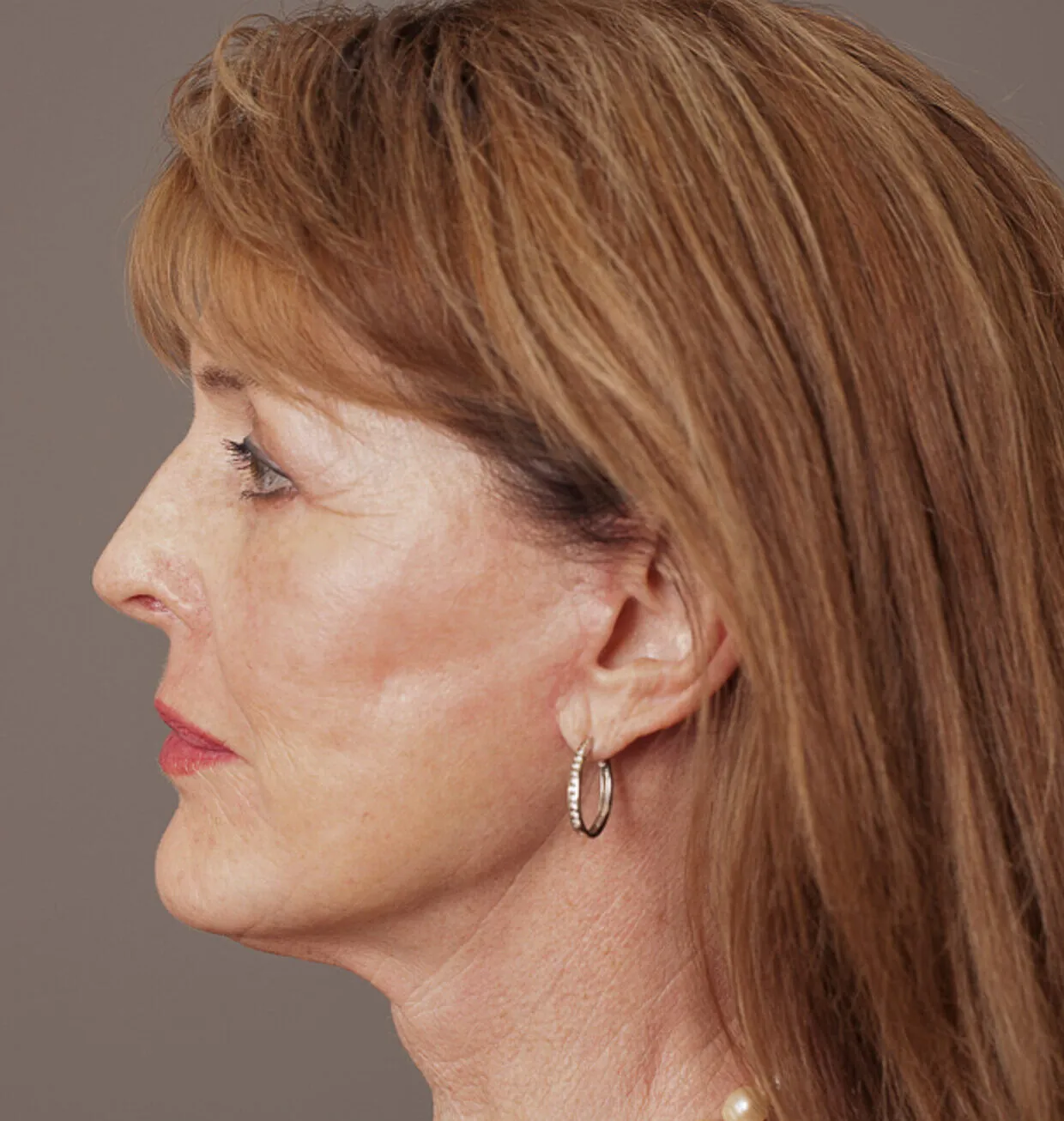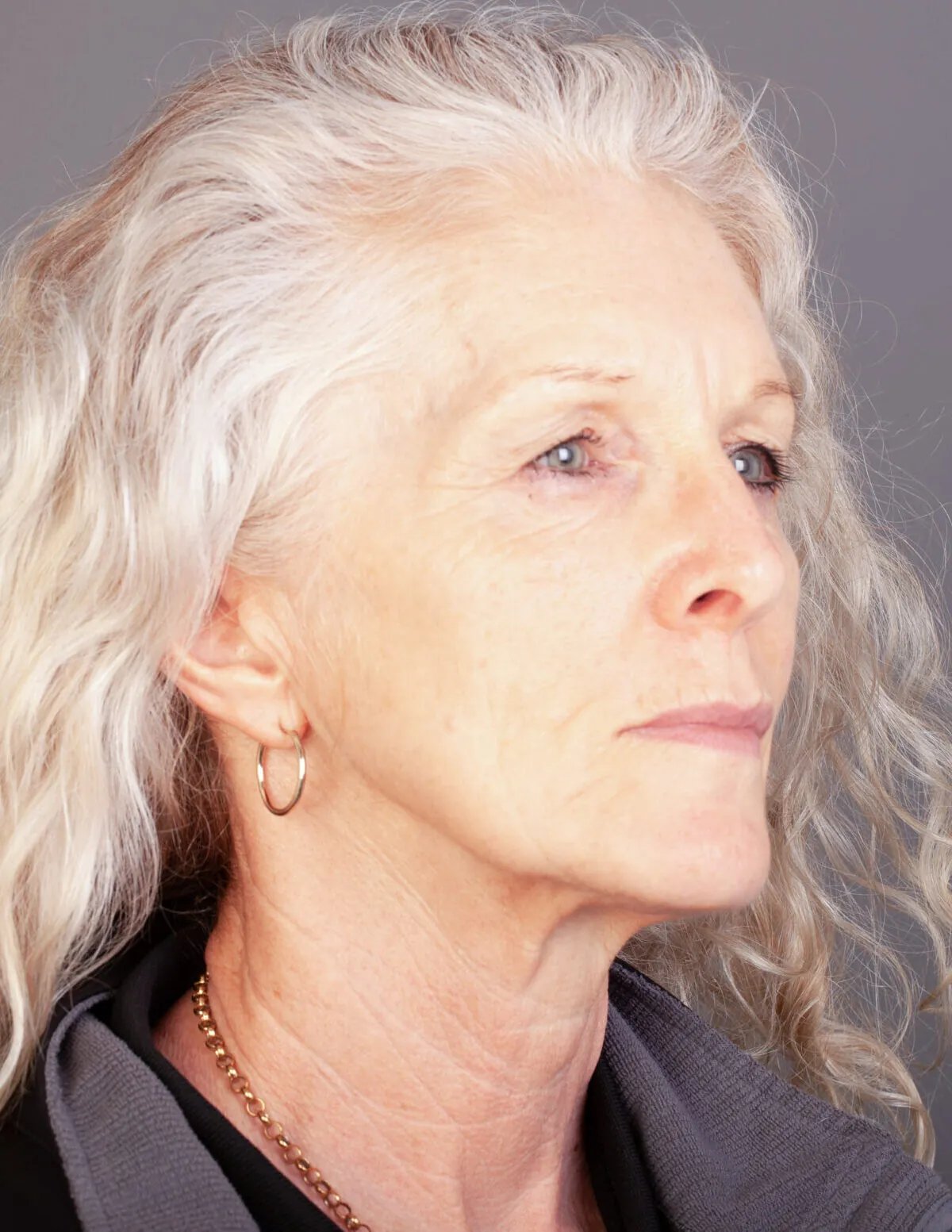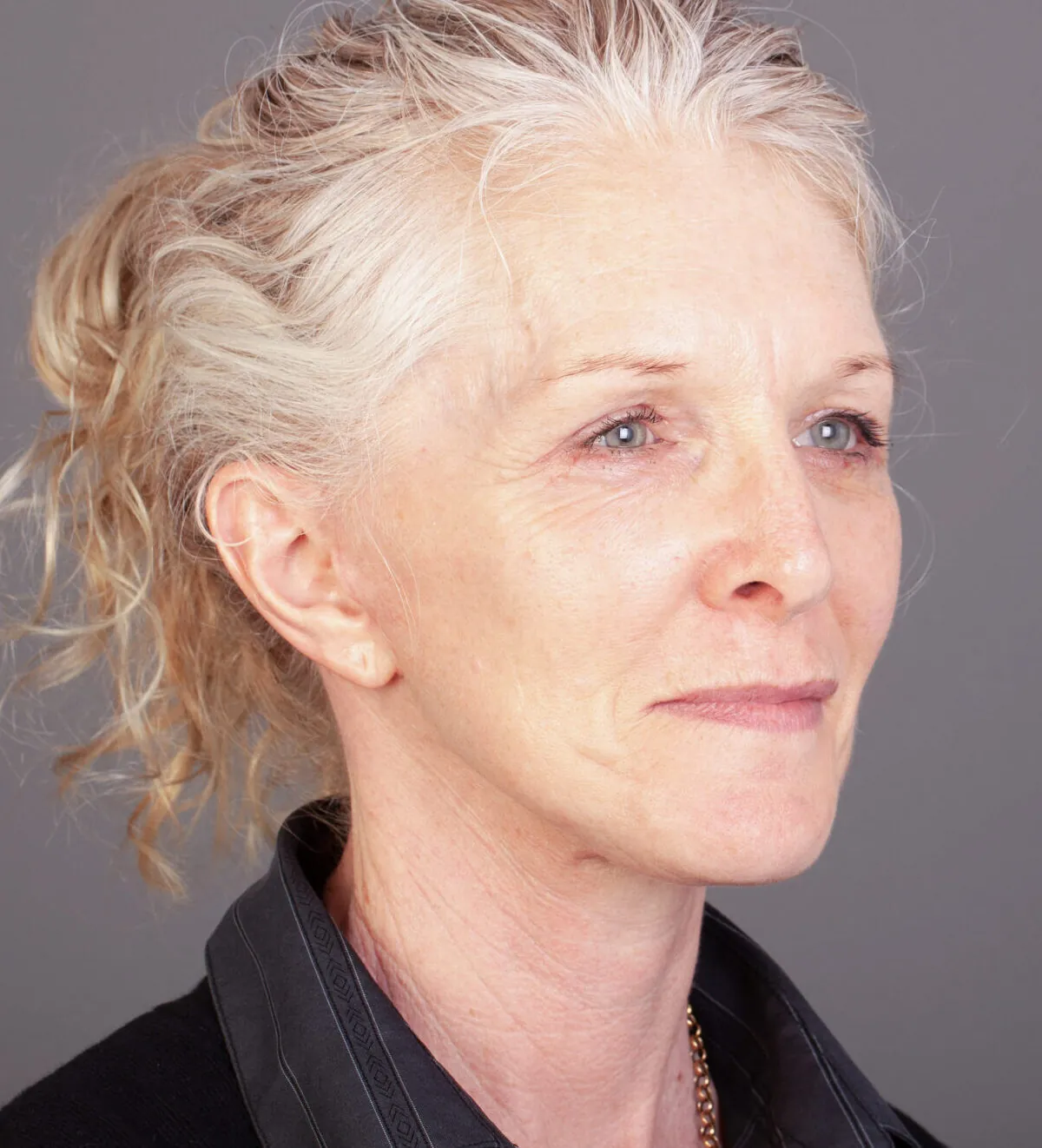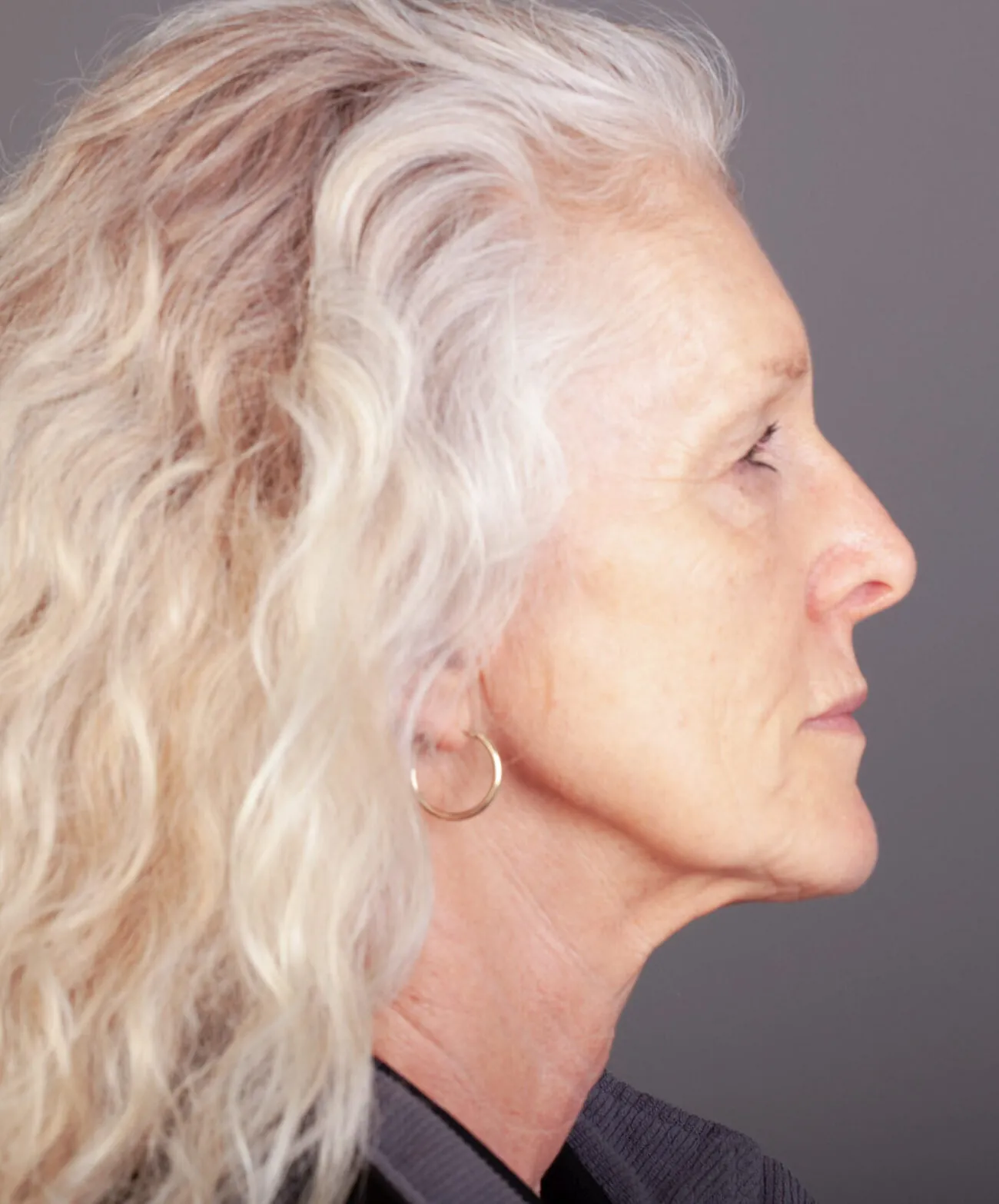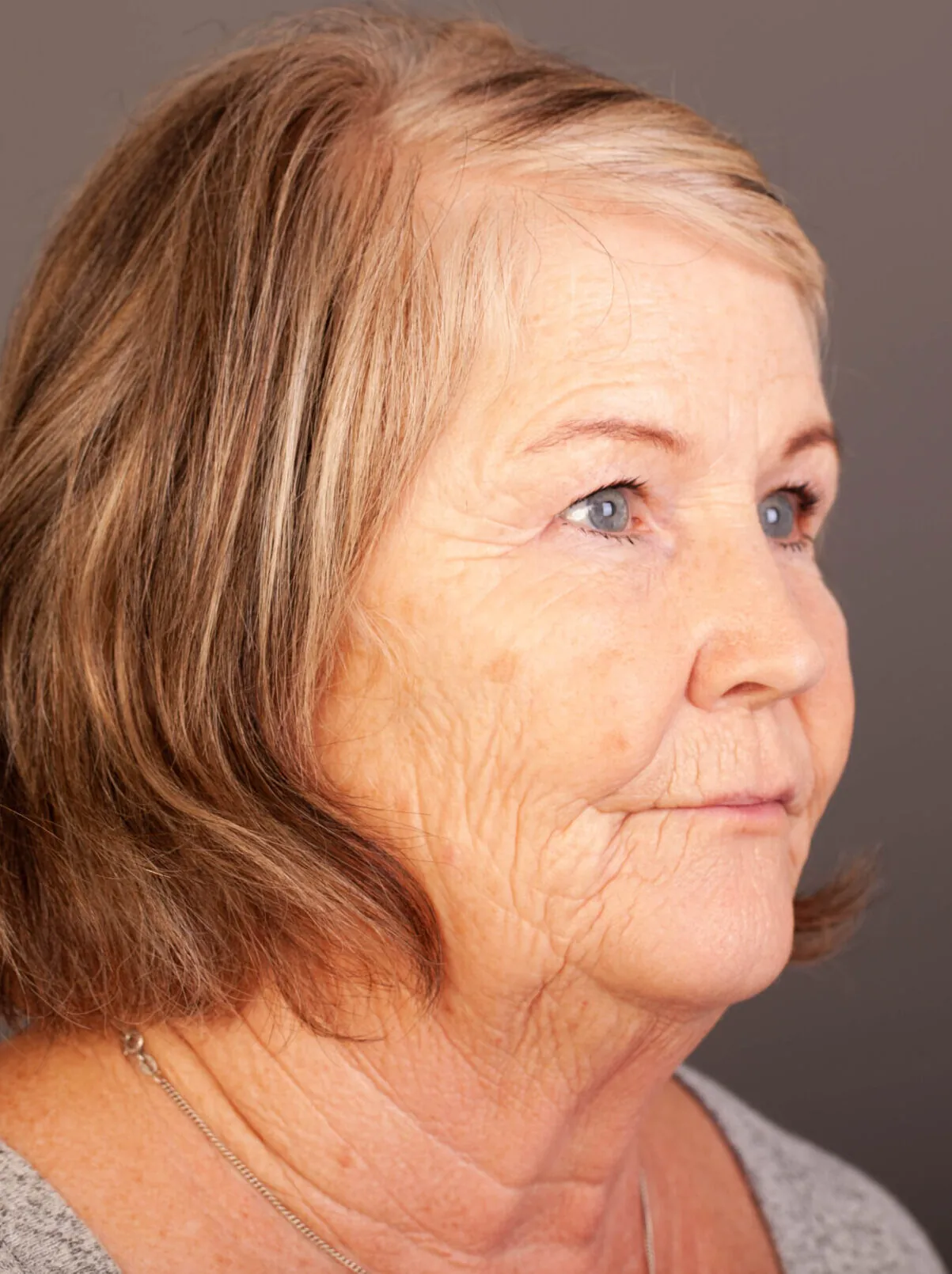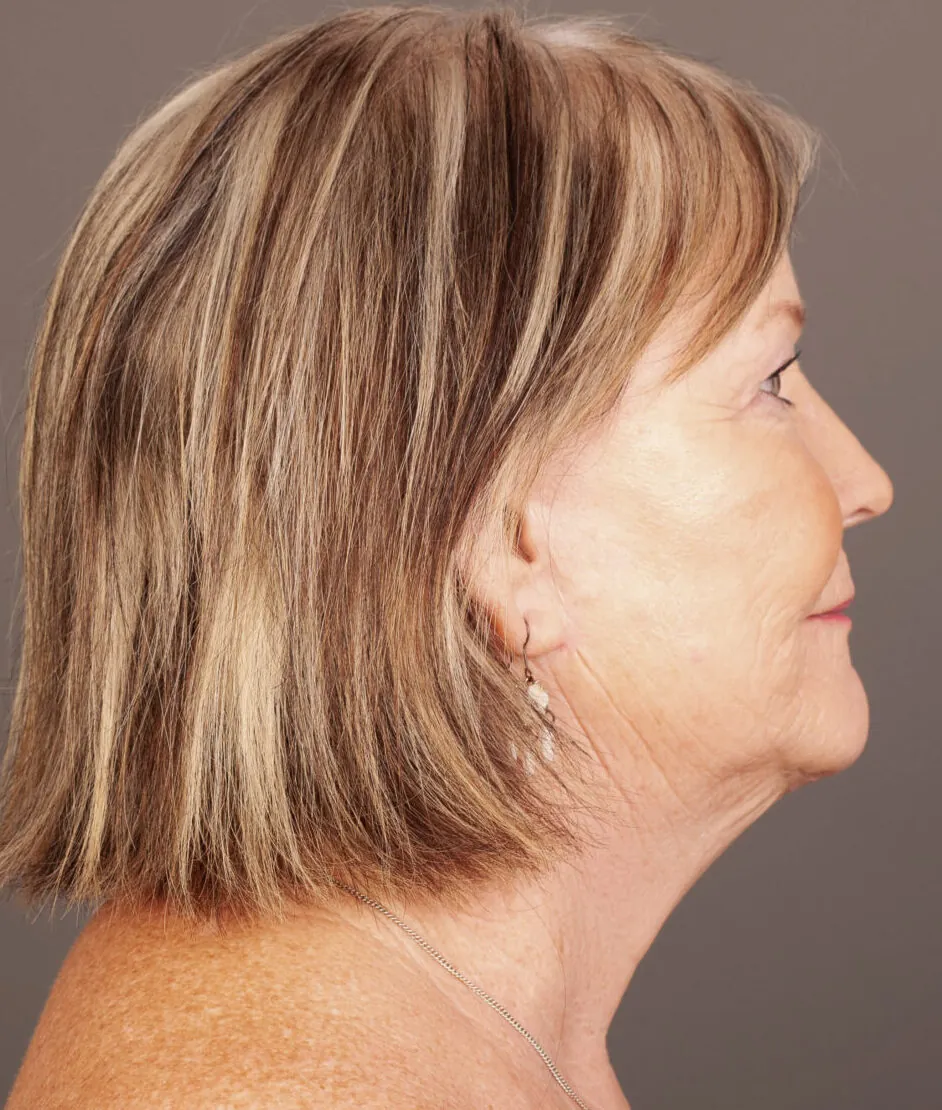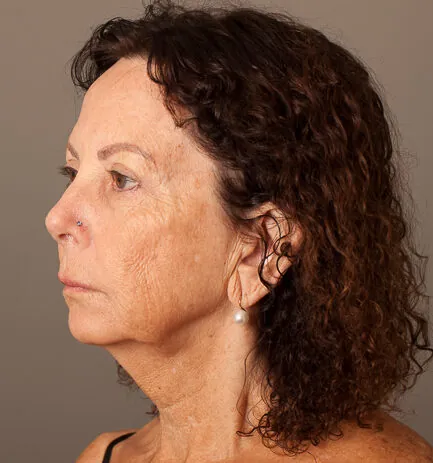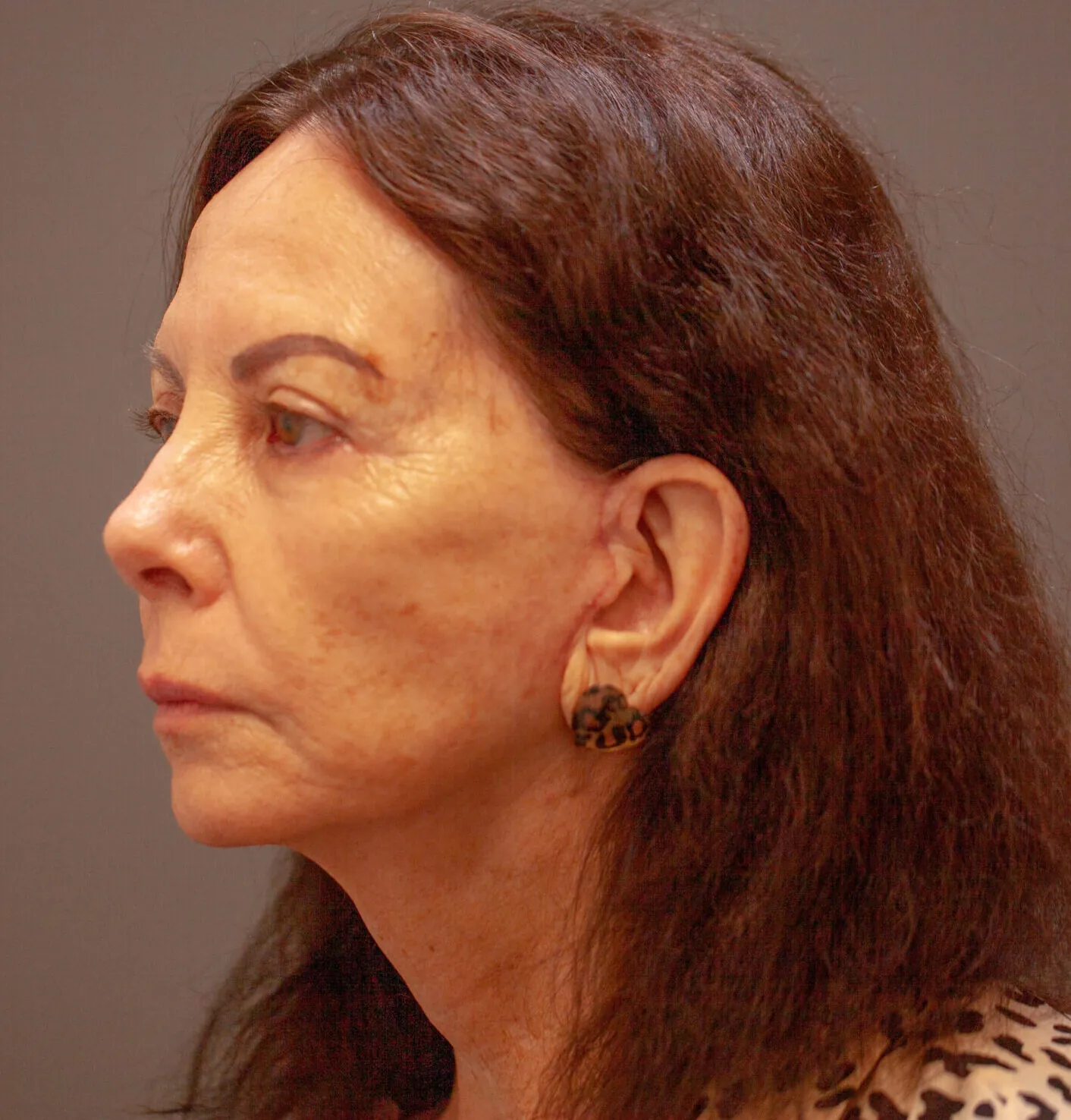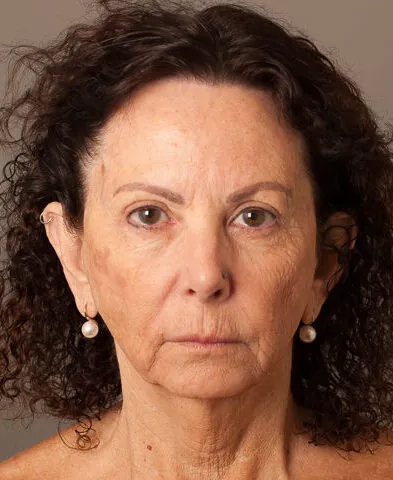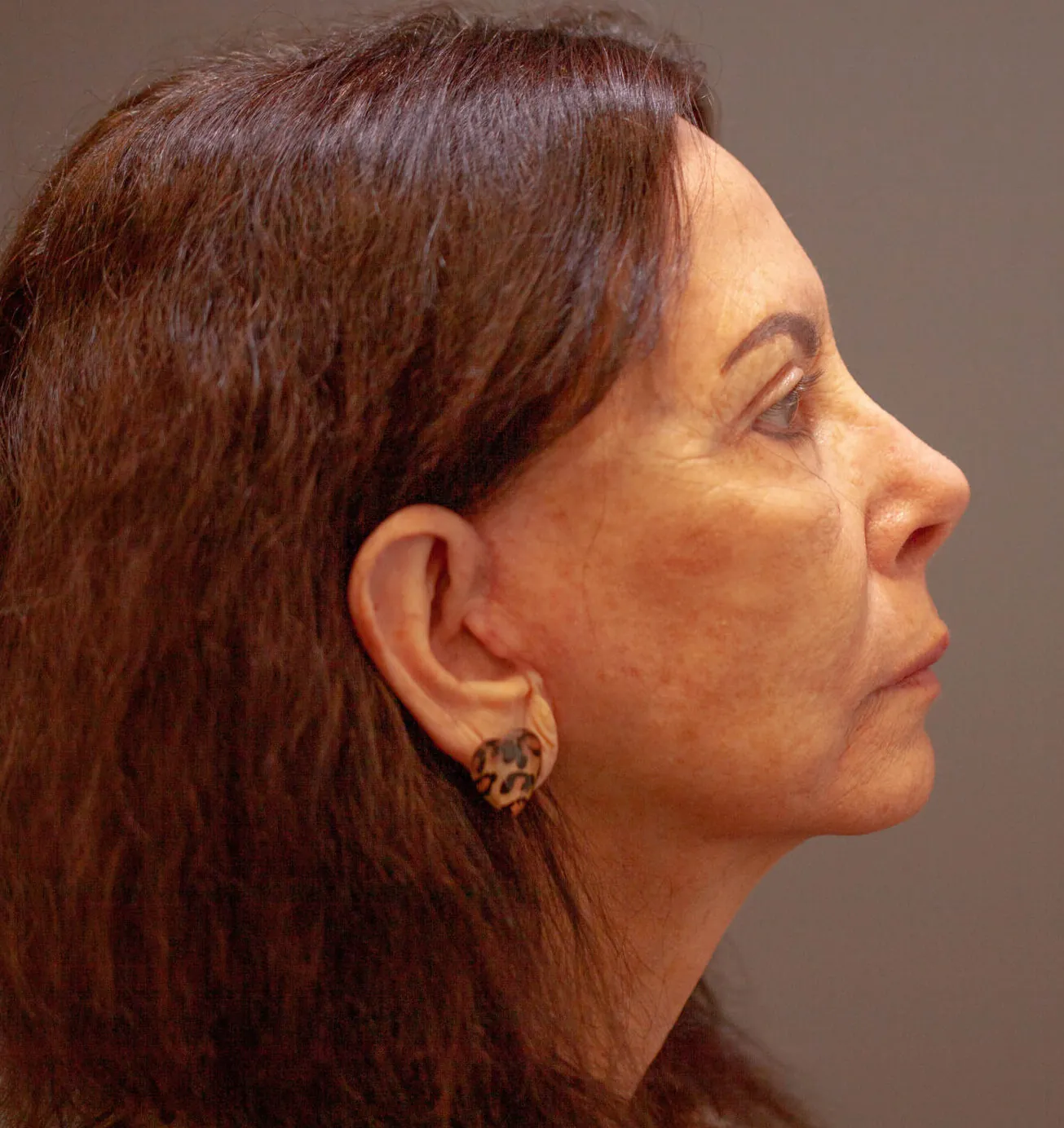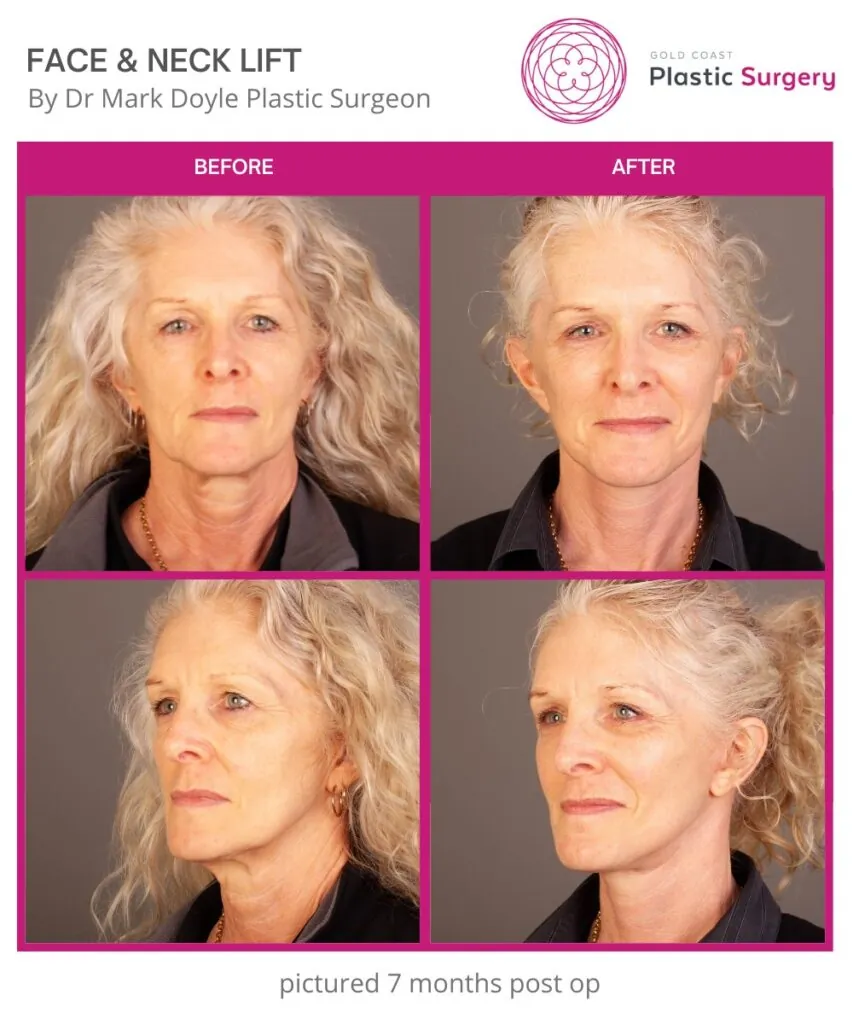As we age, the skin on our face can lose its elasticity, causing it to become loose and develop fine lines. While there are non-surgical treatments available to address these concerns, sometimes surgical options may be recommended. This is where a facelift, also known as a rhytidectomy, may be a suitable option. A face lift is a surgical procedure that may be able to remove excess skin, tighten the underlying muscles and lift the facial skin.
Face Lift Surgery, at a glance
Target area: Loose skin and nasolabial lines
Time off work: 1 – 2 weeks
Total recovery: 6 weeks
Compression garment: 2 weeks full time wear, 6 weeks total
Scar position: In front of ears, around the earlobe & into hair line
What Is a Face Lift?
A face lift is a cosmetic surgical procedure that can tighten the facial skin and muscles. The procedure involves making incisions around the hairline and ears, lifting and repositioning the skin, tightening the underlying muscles, and removing excess skin. The result is firmer facial skin. While a facelift is not a permanent solution to the natural aging process, it can provide surgical results. It is important to have a consultation with a qualified plastic surgeon to determine if you are a suitable candidate for a face lift and to discuss your surgery goals and surgery expectations for the procedure.
Types of Face Lifts
Face lift surgery is an individualised procedure that can be tailored to meet the specific recommendations and surgery goals of each patient. There are several types of facelift surgeries, each designed to address different concerns and provide varying degrees of improvement. Here are some of the most common types of face lifts:
| Type of Face Lift | Procedure | Incision Placement | Targeted Area | Recovery Time | Ideal Candidate |
| Full Face Lift | Comprehensive | Hairline, around ears, sometimes under chin | The middle third of the face | 2-3 weeks | Advanced signs of excess and loose skin. |
| Mini Face Lift | Less invasive | In front of ears | Lower two-thirds of the face | 1-2 weeks | Mild to moderate signs of excess and loose skin. |
| SMAS Face Lift | Underlying muscles focused | Hairline, around ears | Lower two-thirds of the face | 2-3 weeks | Excess facial tissues |
| Deep Plane Face Lift | Extensive procedure | Hairline, around ears- Slightly longer incisions | Lower two-thirds of face | 3-4 weeks | Significant signs of excess and loose skin. |
Full Face Lift
Full face lift also known as a traditional face lift, is a procedure that targets the entire face and involves making incisions along the hairline, around the ears, and sometimes under the chin. It can tighten and lift the skin, remove excess fat, and reposition the underlying muscles for tighter skin.
Mini Facelift
A mini face lift (also called S lift, or mini lift) is a facial procedure. Mini face lift is performed to tighten your face and neck and reduce fine lines and skin folds that may be visible on your jaw and neckline. In comparison with the traditional facelift, a mini facelift is generally a less extensive surgical procedure. Most suitable for patients who have only mild to moderate signs of skin laxity, and who are not recommended a full face lift.
Many clinics market the mini face lift as a very simple “lunchtime lift” or “weekend face lift”, implying that it’s almost an effortless procedure; however, this is not accurate. Despite its name, the mini face lift is still a complex surgical procedure. Only highly skilled certified specialist plastic surgeons should perform this procedure. Experienced specialist plastic surgeons, like Dr Doyle, perform the mini facelift with surgical experience and the techniques they were taught during their 10+ years of plastic surgery training. Dr Doyle is passionate about patient care and achieving the best patient surgical outcomes. Please note, like with any other surgical procedure, you will need time to recover after surgery.
SMAS Lift
The SMAS (superficial musculoaponeurotic system) face lift is a surgical technique for facial tightening and targets the underlying muscles of the face. This procedure involves making incisions around the hairline and ears to access the SMAS layer, which is a thin layer of fibrous tissue that covers the muscles of the face. By lifting and repositioning the SMAS layer, the surgeon can create a firmer, tighter face. This technique can also be combined with other procedures, such as facial fat transfer or eyelid surgery, for comprehensive surgery results.
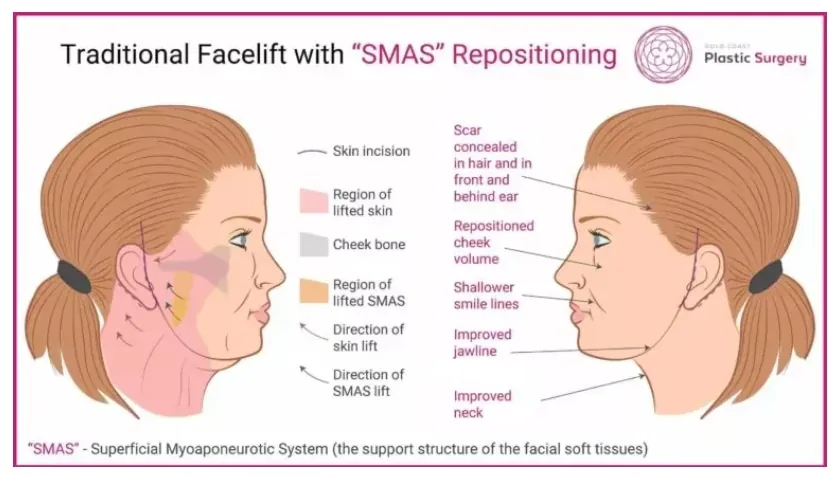
Deep Plane Facelift
A deep plane facelift is a facial procedure and a type of facelift. The procedure can be combined with other surgeries to achieve preferred patient results. This facial procedure is best suited for patients who are seeking excess facial skin reduction. The results from this cosmetic surgery can be seen in before and after photos, and it is advisable to discuss the procedure within a consultation with Gold Coast Plastic Surgeon Dr Mark Doyle for more information. This is a more extensive type of facelift that targets the deep tissues and muscles of the face. It involves making incisions along the hairline and around the ear to access the deep plane layer, which is located below the SMAS layer. The deep plane facelift can provide a firmer facial appearance in the mid-face and jowl areas.
Facelift Surgery Benefits
Facelift surgery can tighten loose facial skin, reduce the appearance of fine lines, and increase facial volume for a firmer appearance. It can also address excess skin around the neck and jawline, a concern for many patients. Other potential benefits of facelift surgery include increased facial symmetry and a firmer face and neckline.
“During facelift surgery with me, I generally prefer to use the SMAS facelift technique to reduce the loose facial skin and tighten the facial muscles.”
– Specialist Plastic Surgeon Dr Mark Doyle
Suitable Candidate
Not everyone is a suitable candidate for face lift surgery. The procedure is typically recommended for individuals who are in good overall health and have realistic expectations for the results of the procedure. In general, a suitable candidate for face lift surgery:
- Is in good physical health and does not have any medical conditions that could increase the risk of complications during or after the surgery.
- Has noticeable signs of loose skin, fine lines, or excess skin around the neck and jawline.
- Has realistic expectations for the results of the procedure and understands that a face lift cannot stop the natural aging process.
- Is a non-smoker or is willing to quit smoking for a period of time before and after the procedure to reduce the risk of complications and promote healing.
- Is willing to follow the pre-and post-operative instructions provided by their plastic surgeon to ensure the best possible outcome.
It is important to note that each individual is unique and that a consultation with a qualified specialist plastic surgeon is necessary to determine if facelift surgery is suitable for you.
Face Lift Procedure
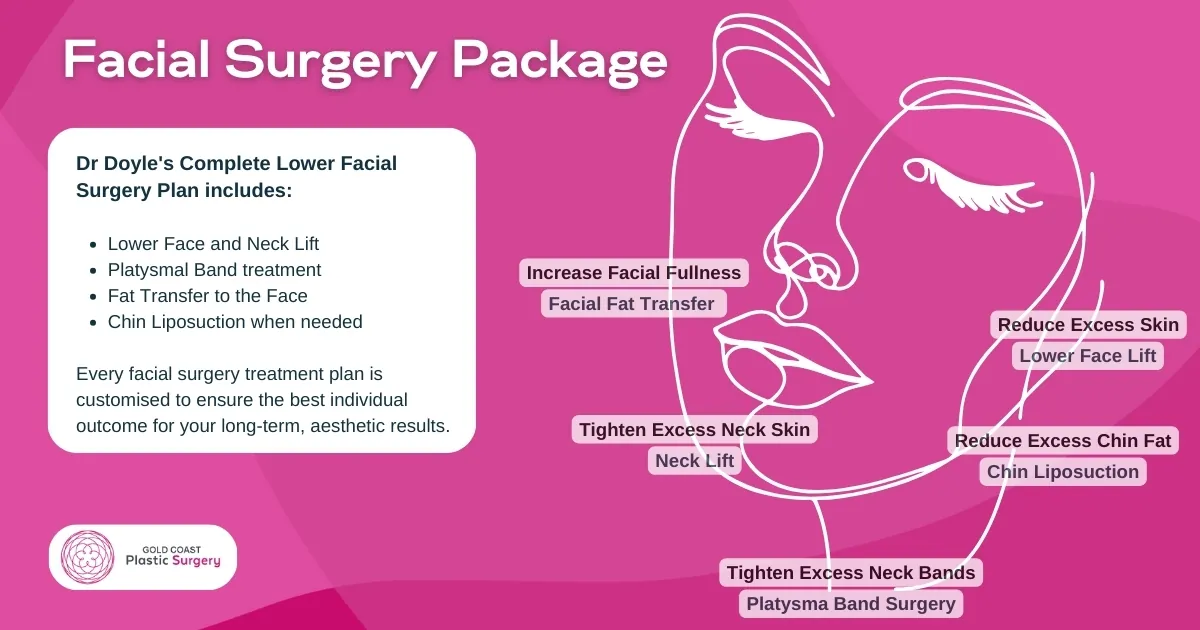
The face lift procedure typically involves several steps to address excess skin on the face and neck. First, the patient will be given general anaesthesia to ensure their comfort during surgery. Then, Dr Doyle will make incisions in strategic locations based on the type of facelift being performed. The underlying muscles and tissues will be repositioned and tightened to create a firmer, tighter face. Excess skin will be removed, and the remaining skin will tightened. Additional procedures, such as fat grafting, may also be performed for preferred results. It’s important to choose a qualified plastic surgeon and follow pre- and post-operative instructions to minimise the risk of complications and achieve your surgery goals.
Face Lift Before and After | Real Patient Gallery
Disclaimer: All information on the Gold Coast Plastic Surgery website is general in nature and is not intended to be medical advice, nor does it constitute a doctor-patient relationship. Results can vary significantly and depend on individual patient circumstances. Please be aware that the outcomes shown are specific to those patients and may not necessarily reflect the results others may experience. Individual results can vary due to many factors, including genetics, diet, and exercise. All images on this website, unless specified as real patient images, are graphics used for illustrative purposes only. Surgery risks and complications will be covered in detail during a consultation with your surgeon. Book a consult for details regarding your cosmetic surgery procedure.
Face & Neck Lift

Face & Neck Lift

Face & Neck Lift

Face & Neck Lift

Face & Neck Lift
View All Face Lift Images by Dr Doyle
Download the Guide
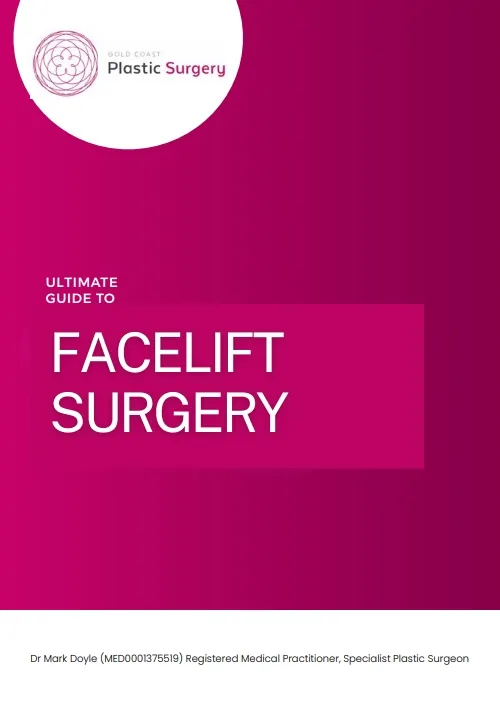
Recovery and After Care
After surgery, it’s vital to take time to properly recover in order to achieve the best possible surgical results and minimise the appearance of facelift scars. Recovery time will vary depending on the individual and the extent of the procedure, but generally, patients can expect to experience swelling, bruising, and some discomfort for the first 1 -2 weeks. Post-operative care instructions may include keeping your head elevated, applying ice to reduce swelling, and avoiding strenuous activities. Protecting the incision sites from UV radiation is also important to prevent the darkening of scars. Most patients can return to normal activities within two to three weeks, but full recovery can take several months. Your surgeon will monitor progress and guide scar management techniques to minimise the appearance of facelift scars over time.
Facelift Surgery Results
For surgery results from a face lift procedure, it’s important to take good care of your facial skin and overall health. This may include maintaining a healthy diet, getting regular exercise, avoiding smoking and excessive sun exposure. Additionally, using high quality skin care products and undergoing periodic maintenance treatments, such as chemical peels or laser resurfacing, can help to prolong the results of facelift surgery. It’s important to follow the specific aftercare instructions provided by your surgeon to minimise the risk of complications and achieve the best possible surgical outcome. Regular check-ups with your surgeon can also help identify and address any concerns before they become more significant.
Book Your Free 15 Minute Phone Chat Now
Risk and Complications
Like any surgical procedure, face lift surgery carries certain risks and potential complications. By following all pre-operative and post-operative instructions provided by your surgeon and closely monitoring your recovery, you can minimise your risk of complications.
Risks may include:
- Infection
- Bleeding
- Scarring
- Blood clots
- Delayed wound healing
- Anaesthesia risks
Minimising Risks with a Skilled Specialist Plastic Surgeon
Choosing a skilled and experienced specialist plastic surgeon is crucial for minimising risks. Dr Mark Doyle is a specialist plastic surgeon with extensive experience in facial plastic surgery and a commitment to patient safety. During your initial consultation, Dr Doyle will thoroughly evaluate your facial structure, discuss your surgery goals and expectations for the procedure and provide detailed information on the risks and benefits associated with face lift surgery. With Dr Doyle’s expertise and education, you can be well informed when it comes to your surgery decision.
Next Step – Book a Facelift Consult with Dr Doyle on the Gold Coast
Book a consultation with Specialist Plastic Surgeon, Dr Mark Doyle on the Gold Coast today. He consults with patients from Brisbane and Gold Coast to assess if face lift surgery is suitable for them.
Medical References:
- Safety and Adjuncts in Face Lifting – Plastic and Reconstructive Surgery Journal
- Treatments and Procedures: Facelift and Mini-Facelift – Hopkins Medicine
- What are the steps of a facelift procedure? – American Society of Plastic Surgeons
- Facelift – the current concept of complex facial renewing
About Dr Mark Doyle FRACS (Plas) – Queensland Plastic Surgeon
Servicing patients in Gold Coast, Brisbane, Sunshine Coast, Cairns and New South Wales NSW – Northern Rivers, Byron Bay, Ballina, Lismore and more.
Dr Mark Doyle is a fully qualified Specialist Plastic Surgeon with over 30 years of experience performing breast, body, face and nose surgery. He has completed all required training and only carries out approved surgical practices. There are NO undertrained doctors or cosmetic doctors acting as surgeons at Gold Coast Plastic Surgery.


